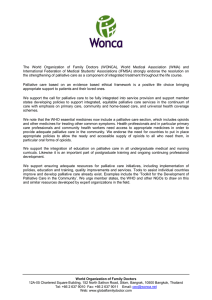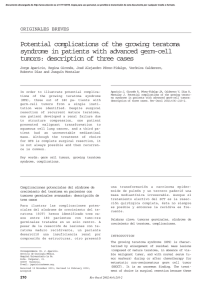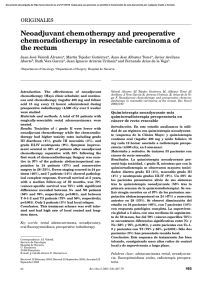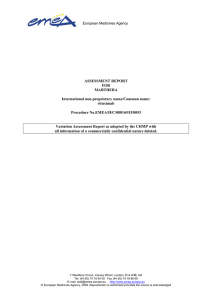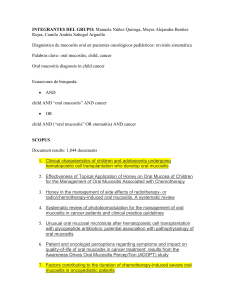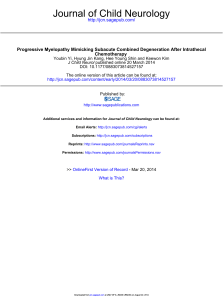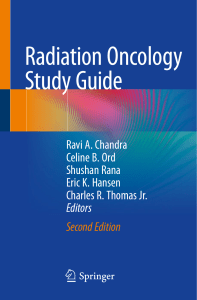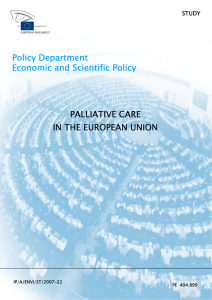cancer chemotherapy near the end of life: the time
Anuncio
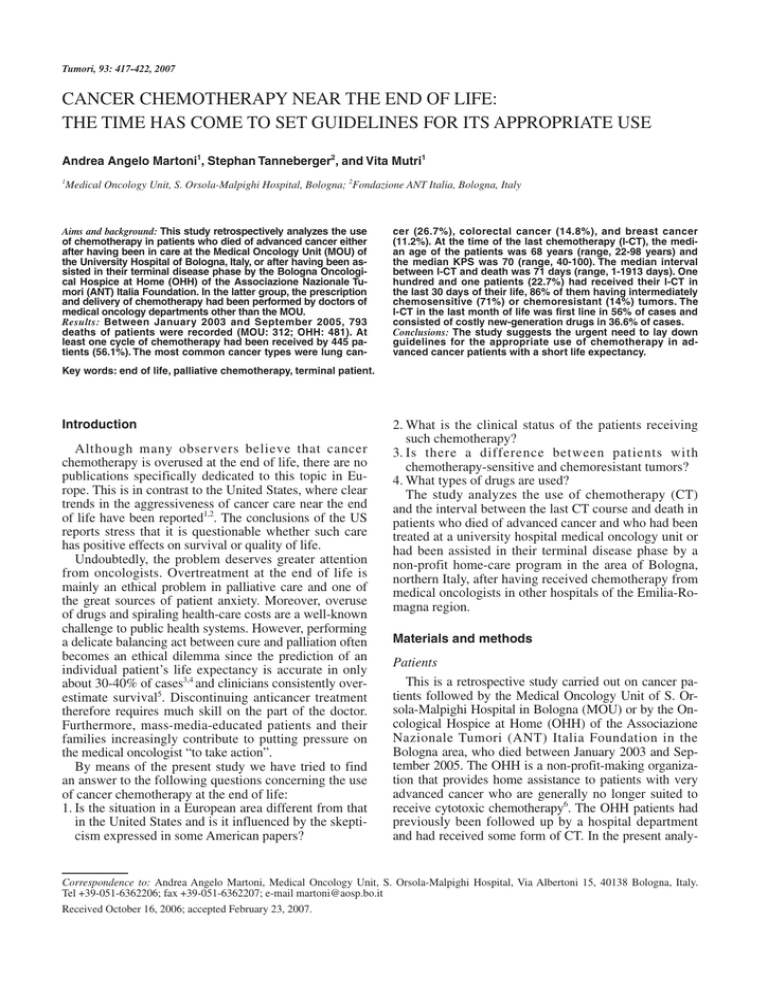
Tumori, 93: 417-422, 2007 CANCER CHEMOTHERAPY NEAR THE END OF LIFE: THE TIME HAS COME TO SET GUIDELINES FOR ITS APPROPRIATE USE Andrea Angelo Martoni1, Stephan Tanneberger2, and Vita Mutri1 1 Medical Oncology Unit, S. Orsola-Malpighi Hospital, Bologna; 2Fondazione ANT Italia, Bologna, Italy Aims and background: This study retrospectively analyzes the use of chemotherapy in patients who died of advanced cancer either after having been in care at the Medical Oncology Unit (MOU) of the University Hospital of Bologna, Italy, or after having been assisted in their terminal disease phase by the Bologna Oncological Hospice at Home (OHH) of the Associazione Nazionale Tumori (ANT) Italia Foundation. In the latter group, the prescription and delivery of chemotherapy had been performed by doctors of medical oncology departments other than the MOU. Results: Between January 2003 and September 2005, 793 deaths of patients were recorded (MOU: 312; OHH: 481). At least one cycle of chemotherapy had been received by 445 patients (56.1%). The most common cancer types were lung can- cer (26.7%), colorectal cancer (14.8%), and breast cancer (11.2%). At the time of the last chemotherapy (l-CT), the median age of the patients was 68 years (range, 22-98 years) and the median KPS was 70 (range, 40-100). The median interval between l-CT and death was 71 days (range, 1-1913 days). One hundred and one patients (22.7%) had received their l-CT in the last 30 days of their life, 86% of them having intermediately chemosensitive (71%) or chemoresistant (14%) tumors. The l-CT in the last month of life was first line in 56% of cases and consisted of costly new-generation drugs in 36.6% of cases. Conclusions: The study suggests the urgent need to lay down guidelines for the appropriate use of chemotherapy in advanced cancer patients with a short life expectancy. Key words: end of life, palliative chemotherapy, terminal patient. Introduction Although many observers believe that cancer chemotherapy is overused at the end of life, there are no publications specifically dedicated to this topic in Europe. This is in contrast to the United States, where clear trends in the aggressiveness of cancer care near the end of life have been reported1,2. The conclusions of the US reports stress that it is questionable whether such care has positive effects on survival or quality of life. Undoubtedly, the problem deserves greater attention from oncologists. Overtreatment at the end of life is mainly an ethical problem in palliative care and one of the great sources of patient anxiety. Moreover, overuse of drugs and spiraling health-care costs are a well-known challenge to public health systems. However, performing a delicate balancing act between cure and palliation often becomes an ethical dilemma since the prediction of an individual patient’s life expectancy is accurate in only about 30-40% of cases3,4 and clinicians consistently overestimate survival5. Discontinuing anticancer treatment therefore requires much skill on the part of the doctor. Furthermore, mass-media-educated patients and their families increasingly contribute to putting pressure on the medical oncologist “to take action”. By means of the present study we have tried to find an answer to the following questions concerning the use of cancer chemotherapy at the end of life: 1. Is the situation in a European area different from that in the United States and is it influenced by the skepticism expressed in some American papers? 2. What is the clinical status of the patients receiving such chemotherapy? 3. Is there a difference between patients with chemotherapy-sensitive and chemoresistant tumors? 4. What types of drugs are used? The study analyzes the use of chemotherapy (CT) and the interval between the last CT course and death in patients who died of advanced cancer and who had been treated at a university hospital medical oncology unit or had been assisted in their terminal disease phase by a non-profit home-care program in the area of Bologna, northern Italy, after having received chemotherapy from medical oncologists in other hospitals of the Emilia-Romagna region. Materials and methods Patients This is a retrospective study carried out on cancer patients followed by the Medical Oncology Unit of S. Orsola-Malpighi Hospital in Bologna (MOU) or by the Oncological Hospice at Home (OHH) of the Associazione Nazionale Tumori (ANT) Italia Foundation in the Bologna area, who died between January 2003 and September 2005. The OHH is a non-profit-making organization that provides home assistance to patients with very advanced cancer who are generally no longer suited to receive cytotoxic chemotherapy6. The OHH patients had previously been followed up by a hospital department and had received some form of CT. In the present analy- Correspondence to: Andrea Angelo Martoni, Medical Oncology Unit, S. Orsola-Malpighi Hospital, Via Albertoni 15, 40138 Bologna, Italy. Tel +39-051-6362206; fax +39-051-6362207; e-mail [email protected] Received October 16, 2006; accepted February 23, 2007. 418 AA MARTONI, S TANNEBERGER, V MUTRI sis, patients assisted by MOU and subsequently by OHH were assigned to the MOU series. Consequently, the patients of the OHH group received cytotoxic chemotherapy treatment at a hospital department other than the MOU in the Bologna province or other areas of EmiliaRomagna. The analysis was carried out using MOU and OHH files, searching for patients who died in the period studied. Data concerning sex, age and type of primary tumor were collected from these patients’ case histories. Definition of last chemotherapy Patients who had begun at least one CT regimen for advanced disease at any time during their lifetime were selected from the general group of deceased patients. Last chemotherapy (l-CT) was defined as the last administration of anticancer drugs. The type of cytotoxic agents, the number of the cycle and of the treatment line, the interval in days between the date of last administration and the date of death, age and KPS at the time of l-CT were collected from the patient’s case history and analyzed. The following classification was adopted in order to analyze the results according to tumor chemosensitivity: highly sensitive tumors (breast, ovary, testis, lymphoma and leukemia), intermediately sensitive tumors (lung, colorectum, head and neck, esophagus, uterus, unknown primary, bladder, peritoneum) and low chemosensitive/chemoresistant tumors (kidney, pancreas, melanoma, soft tissue sarcomas, liver, CNS, stomach, prostate, thyroid). The cytotoxic agents were classified into 2 groups: 1) old-generation drugs and 2) new-generation drugs. The cost for the hospital of each single anticancer agent was calculated on a month-long treatment basis. Data analysis The data were collected in an Excel Windows-Office XP (Microsoft) spreadsheet, by means of which they were subsequently processed. years but was higher in OHH patients than in MOU patients (77 vs 66 years). In the vast majority of patients (94.2%) the cause of death was cancer, with no differences between the 2 series; in 5 patients (0.7%) death was related to the toxicity of the treatments received. Patients who had received CT Four hundred and forty-five of the 793 deceased patients (56.1%) had received at least 1 cycle of chemotherapy for advanced cancer: 157 of these belonged to the OHH series (35.3%) and 288 to the MOU series (64.7%). The characteristics of the patients who had received CT and the description of the l-CT are reported in Table 2. This analysis refers to the total number of patients treated without differentiating between the 2 series, as there were no substantial differences, with the exception of the median age of the patients, which continued to be higher in the OHH than in the MOU series (71 vs 66 years). The interval between l-CT and death was 71 days (range, 1-1913 days). A shorter interval was reported for patients with lung and pleura tumors than for patients with colorectal, breast and other tumors (46 days vs 75, 80 and 78 days, respectively). In 79.1% of patients l-CT was delivered over the last 6 months. Information on KPS at the time of l-CT was available only for the MOU series: the median KPS was 70 (range, 40-100). The most common primary tumors were lung and pleural cancer, colorectal cancer and breast cancer, while other primary tumors accounted for 47.3%. The tumor distribution according to chemosensitivity was as follows: high 19.8%, intermediate 58.0%, and low 22.2%. The majority of the patients belonging to the third group had been treated in their last 6 months of life. L-CT consisted of conventional drugs in 57.1% of cases, while 35.8% has been treated with newgeneration drugs. In about 50% of the patients, l-CT was first-line CT and in 46.5% of cases it was at the fourth or subsequent cycle. Chemotherapy in the last month of life Results A total of 793 deceased patients were identified in the time period considered: 312 in the MOU database and 481 in the OHH database. Their general characteristics are reported in Table 1. The median age at death was 73 Table 3 shows the main characteristics of 101 patients, corresponding to 22.7% of patients who had received CT and to 12.7% of all considered patients, who had received CT in their last 30 days of life. They included 72.3% men and 69.3% patients aged ≥65 years. Table 1 - General characteristics of deceased patients General characteristics Patients screened Median age (range) Men/women Causes of death Cancer Toxicity Other causes Unknown Patients who had received palliative CT OHH MOU Total 481 77 (33-103) 259 (54%) / 222 (46%) 312 66 (22-89) 184 (59%) / 128 (41%) 793 73 (22-103) 443 (56%) / 350 (44%) 461 (95.8%) 2 (0.4%) 18 (3.9%) – 157 (32.4%) 286 (91.7 %) 3 (1%) 9 (3.1%) 14 (4.9%) 288 (92.3%) 747 (94.2%) 5 (0.7%) 27 (3.6%) 14 (1.9%) 445 (56.1%) OHH, Oncological Hospice at Home; MOU, Medical Oncology Unit, University Hospital, Bologna; CT, chemotherapy. 419 GUIDELINES FOR CANCER CHEMOTHERAPY NEAR THE END OF LIFE Table 2 - Patient and CT characteristics according to interval between last CT and death Pts who had received CT No. (%) Pts with last CT in last 180 days before death No. (%) Pts with last CT >180 days before death No. (%) Patients who had received palliative CT 445 (100) 352 (79.1) 93 (20.9) Sex Men Women 264 (59.3) 181 (40.7) 216 (81.8) 136 (75.1) 48 (18.2) 45 (24.9) Age Median (range) <65 years ≥65 years 68 (22-98) 176 (39.6) 269 (60.4) 67 (22-98) 150 (85.2) 202 (75.1) 71 (37-87) 26 (14.8) 67 (24.9) KPS Median (range) 70-100 <70 Data not available* 70 249 39 157 (40-100) (56.0) (8.7) (35.3) 70 205 27 120 (40-100) (82.3) (69.2) (76.4) 70 44 12 37 (40-100) (17.7) (30.8) (23.6) Primary tumor Colorectal Lung and pleura Breast Others 66 119 50 210 (14.8) (26.7) (11.2) (47.3) 53 102 39 158 (80.3) (85.7) (78.0) (75.3) 13 17 11 52 (19.7) (14.3) (22.0) (24.7) CT sensitivity** High Intermediate Low 88 (19.8) 258 (58.0) 99 (22.2) 66 (75.0) 206 (79.8) 80 (80.8) 22 (25.0) 52 (20.2) 19 (19.2) Cytotoxic drugs Old drugs New drugs Data not available 254 (57.1) 160 (35.9) 31 (7.0) 196 (77.2) 133 (83.1) 23 (74.2) 58 (22.8) 27 (16.9) 8 (25.8) Lines of CT 1 2-3 >3 Data not available 222 168 45 10 (49.9) (37.8) (10.1) (2.2) 176 133 37 6 (79.3) (79.2) (82.2) (60.0) 46 35 8 4 (20.7) (20.8) (17.8) (40.0) Number of cycles 1 2-3 >3 Data not available 79 154 207 5 (17.8) (34.6) (46.5) (1.1) 62 131 156 3 (78.5) (85.1) (75.4) (60.0) 17 23 51 2 (21.5) (14.9) (24.6) (40.0) *KPS at the time of the last CT not available in patients of OHH; **highly sensitive tumors: breast, ovary, testis, lymphoma and leukemia; intermediately sensitive tumors: lung and pleura, colorectal, head and neck, esophagus, uterus, unknown primary, bladder, peritoneum; low sensitive tumors: kidney, pancreas, melanoma, soft tissue sarcoma, liver, CNS, stomach, prostate, thyroid. KPS, Karnofsky performance status; CT, chemotherapy; OHH, Oncological Hospice at Home. KPS was not available in 30.7% of the cases and was 70-100 in 60.4% and <70 in 8.9%. Lung and pleural cancer accounted for 40.6% of this group of patients, colorectal cancer for 16.8% and breast cancer for 4%. The majority (71.2%) of patients had intermediately chemosensitive tumors, while patients with highly chemosensitive and poorly chemosensitive tumors were 14.9% and 13.9%, respectively. The l-CT was first line in more than half of these patients (56.4%) and it was at the first cycle in 25.7%, at the second or third cycle in 39.6%, and at the fourth or subsequent cycle in 34.7% of cases. The l-CT was the first cycle of first-line treatment in 15 (15%) patients: they had lung cancer (7), colorectal cancer (3) and other tumors (5); 4 of these patients had chemoresistant tumors. Table 4 describes the type of cytotoxic drugs included in the last CT. It was represented by old-generation-drug- based regimens in 55.5% of cases and new-generationdrug-based regimens in 36.6% of patients. The most common drug in the new-drug-containing regimens was gemcitabine (19.8%). The mean monthly cost of old-generation and new-generation drugs was € 70.38 (range, € 3.70 to € 215.60) and € 954.92 (range, € 725.67 to € 1289.90), respectively. Discussion In the majority of patients with advanced cancer the aim of anticancer drug treatment is palliation, which comprises improvement in quality of life and sometimes overall survival. The use of palliative chemotherapy in advanced cancer patients has progressively grown over the last few decades and it also involves increasing numbers of patients with a short life expectancy. The market 420 AA MARTONI, S TANNEBERGER, V MUTRI Table 3 - Analysis of last CT in the last month of life No. (%) 101 (100) 73 28 (72.3) (27.7) Age Median (range) <65 years ≥65 years 69 31 70 (22-84) (30.7) (69.3) KPS Median (range) 70-100 <70 Data not available* 70 61 9 31 (40-100) (60.4) (8.9) (30.7) Primary tumor Lung and pleura Colorectal Breast Others 41 17 4 39 (40.6) (16.8) (4) (38.6) CT sensitivity** High Intermediate Low 15 72 14 (14.9) (71.2) (13.9) Line of CT 1st 2nd-3rd >3rd Data not available 57 34 9 1 (56.4) (33.7) (8.9) (1.0) Number of cycles 1 2-3 >3 26 40 35 (25.7) (39.6) (34.7) Patients with last CT in the last 30 days of life Sex Men Women *KPS at the time of the last CT not available in patients of OHH; **definition is reported in the section Materials and methods. KPS, Karnofsky performance status; CT, chemotherapy; OHH, Oncological Hospice at Home. Table 4 - Cytotoxic drugs included in the last CT in the last month of life Total number of patients Cytotoxic drugs Old-generation drugs* New-generation drugs Gemcitabine Oxaliplatin Capecitabine Taxanes Oral vinorelbine Irinotecan CT+monoclonal antibody Data not available No. (%) 101 (100) 56 37 20 5 5 3 2 1 1 8 (55.5) (36.6) (19.8) (5) (5) (3) (2) (0.9) (0.9) (7.9) *Antimetabolites (methotrexate, fluoropyrimidines, cytosine arabinoside, thiopurines, hydroxyurea); alkylating agents (melphalan); dialkyltriazenes (dacarbazine); anthracyclines (doxorubicin, epirubicin, daunomycin); bleomycin; mitomycin C; vinca alkaloids (vinblastine, vincristine); podophyllotoxin derivatives (VP-16); platinum analogs (cisplatin, carboplatin); mitoxantrone. CT, chemotherapy. availability of a greater number of anticancer drugs as well as better supportive care has contributed to this phenomenon. In addition, the increased use of CT in patients with advanced disease and with a poor life ex- pectancy has been supported by large clinical trials carried out in the palliative care setting which have demonstrated limited advantages of some cytotoxic agents compared with the best supportive therapy, with statistical power but with dubious clinical significance7,8. As mentioned in the Introduction, many observers believe that cancer chemotherapy is now overused at the end of life, but up until now this issue has raised little interest in clinical research in Europe, with the exception of a few reports published as abstracts9,10. By contrast, the subject has been much analyzed and discussed in the USA by Emanuel and coworkers11. These authors studied chemotherapy use in cancer patients who died in 1996, aged at least 66 years at death, in the six 30-day periods preceding death at the inpatients’, the outpatients’, or carrier Medicare files in Massachusetts and California. Their study showed that 26% to 33% of patients had received CT in the last 6 months of life and that 9% had received it in the last month of life, with no differences in the prevalence of use between people with cancer responsive to CT and cancer unresponsive to CT. Our study illustrates the situation in Bologna, capital of the Emilia-Romagna region in northern Italy, as an example of what typically occurs in a European area. It shows that 56.1% of deceased patients had received at least one CT cycle for advanced disease; this amounts to 44.4% if one considers the last 6 months of life. The percentage was lower in the OHH series than in the MOU series (32.4% vs 92.3%). As the percentage of OHH patients who had received CT for advanced disease is similar to that reported in the American study, it is likely that the OHH sample was representative of the complex and varied case mix of advanced cancer patients destined to die because of the disease, also including patients with very advanced disease at diagnosis and/or severe deterioration in their clinical status and/or very old age who had been excluded from cytotoxic CT. On the other hand, patients belonging to the hospital series represent a population selected specifically to receive anticancer therapy. As the study aimed to outline the use of CT especially in the last phase of the disease, we focused on those patients who received l-CT in the last month of their lives. They represented 22.7% of those who had received CT and 12.7% of the whole series of deceased patients. The latter percentage is similar to that observed by Emanuel and colleagues11. Although there are many differences between the 2 studies in terms of data selection and collection, the nearly overlapping fraction of cancer patients who received CT at the end of life might express a common and generalized phenomenon. As in the US study, the use of CT in the last month of life in our study did not appear to be influenced by the tumor’s chemosensitivity: most of the patients had tumors with intermediate or low chemosensitivity. In addition, our study indicates that in more than half of the patients, the l-CT in the last month of life was first line. The same observation was reported in an another Italian GUIDELINES FOR CANCER CHEMOTHERAPY NEAR THE END OF LIFE study performed in the area of Venice and published only in abstract form, in which 54% of 164 cancer patients treated with CT in the last month of life had not previously received CT for advanced disease10. These findings raise questions as to a) the motivations that are at the basis of the decision to start CT in very advanced cancer patients; b) the aims of this CT and the patient selection criteria; and c) the doctor’s skill in formulating accurate prognostic judgments. One of the main reasons for deciding to start CT for very advanced disease is the patient’s request. A recent systematic review of the literature regarding patient preferences for CT near the end of life shows that the patient’s perspective is different from that of a person in good health. Patients are willing to undergo treatments that have minor benefits with major toxicity. However, at the same time, the patient’s request does not stem from realistic and truthful information on the different treatment options and the likelihood of successful treatments or adverse effects12. On the other hand, the reasons for prescribing CT in patients with poorly responsive or even resistant tumors were clearly not based on scientific evidence. Many factors concerning the information/communication process may underlie the physician’s behavior: the physician may not be able to inform; the physician does not provide information so as to avoid emotional distress; the physician chooses not to be fully honest in an attempt to preserve hope; the physician does not inform the patient because the patient is unable to accept what the physician is saying13. Increasing the physician’s awareness as well as providing correct and complete information suited to the patient’s cultural, psychological and social level and activating earlier a palliative care program at home or at a hospice institution is the path to be followed in order to lessen and even abolish this improper use of CT. In our study, more than 50% of patients who had received CT in the last month of life were at their first line of treatment and 15% even at the first cycle of firstline treatment. As the majority of these patients suffered from intermediately or poorly chemosensitive tumors, it seems clear that also the clinical evaluation criteria at the basis of the decision to prescribe CT are brought into question. Indeed, the palliative effect of CT may be a reasonable objective in such patients even if it can only be achieved in a minority. In these patients, the likelihood of a predominantly negative effect on their quality of life is higher than that of obtaining an improvement. From this study it emerges that, prior to prescribing CT, particular attention should be paid to patients aged over 65 with non-optimal KPS. However, other factors omitted from the present analysis, such as disease extent, presence of comorbidities, and functional status should be included in the decision whether or not to prescribe CT for palliative purposes. Our study shows that older patients with advanced lung cancer to whom CT, most 421 commonly in the form of gemcitabine, is prescribed are the ones with a higher likelihood of being close to death and of having little chance of attaining a palliative effect from the treatment. These observations have recently rekindled the debate on the alternative uses of palliative CT or supportive care in advanced cancer patients approaching the last phases of their lives14,15. An important matter concerns the physician’s skill in making an accurate prognosis and informing the patient and his/her relatives of it in the most appropriate manner. The scientific literature on the doctor’s skill in making prognoses near the end of life has been systematically reviewed by Glare et al.5 They found that although clinician predictions were correlated with actual survival, they tended to overestimate survival. In a previous study carried out at the ANT OHH, long-term clinical experience showed it was possible to improve the accuracy of a clinical estimation of life expectancy; however, many difficulties also arose for physicians who were well trained in end-of-life care, with accurate predictions being made most often for breast and gastrointestinal cancer and least often for urogenital and lung cancer3. A recent meta-analysis on the impact of prognostic factors in advanced cancer confirmed a level A evidence-based correlation for clinical survival prediction, albeit with a series of limitations that clinicians ought to be aware of, while recommendations on the use of other prognostic factors such as performance status, symptoms associated with cancer anorexia-cachexia syndrome, dyspnea, delirium, and some biological factors (leukocytosis, lymphocytopenia and C-reactive protein) only reached level B16. The observations from our study, along with data from the literature, call for prospective studies on accurate prognostication models that incorporate clinical survival predictions. In conclusion, this study underlines the need to lay down guidelines for the decision-making process of prescribing, continuing and stopping CT in cancer patients near the end of life. Among the main factors to be considered, such as the expected sensitivity to the treatment, the adverse effects, and the impact on quality of life (which not only implies physical suffering but also psychological distress and unrealistic hopes), skill in accurately estimating the patient’s prognosis and in communicating with patients and their families plays a key role in defining the appropriateness of CT near the end of life. Inappropriate use of CT in the palliative care setting may have important negative consequences both for patients and the health-care system. The main consequence for the patients is the risk of being administered a useless, toxic and potentially life-threatening treatment, actually resulting in a substantial worsening of the quality of life. The major consequences for the health-care system are the risk of wasting resources that might be efficiently allocated elsewhere. 422 AA MARTONI, S TANNEBERGER, V MUTRI References 1. Earle CC, Neville BA, Landrum MB, Ayanian JZ, Block SD, Weeks JC: Trends in the aggressiveness of cancer care near the end of life. J Clin Oncol, 22: 315-321, 2004. 2. Aragon-Ching JB, Cohn JB, Cohn A: Chemotherapy at the end of life. Proc ASCO, 22: 776, 2003. 3. Tanneberger S, Malavasi I, Mariano P, Pannuti F, Strocchi E: Planning palliative or terminal care: the dilemma of doctors’ prognoses in terminally ill cancer patients. Ann Oncol, 13: 1319-1323, 2002. 4. Christakis NA, Lamont EB: Extent and determinants of error in doctors’ prognoses in terminally ill patients: prospective cohort study. BMJ, 320: 469-472, 2000. 5. Glare P, Virik K, Jones M, Jones M, Hudson M, Eychmuller S, Simes J, Christakis N: A systematic review of physicians’ survival predictions in terminally ill cancer patients. BMJ, 327: 195, 2003. 6. Pannuti F, Tanneberger S: The Bologna Eubiosia project: hospital-at-home care for advanced cancer patients. J Palliat Care, 8: 11-17, 1992. 7. Cunningham D, Pyrhonen S, James RD, Punt CJ, Hickish TF, Heikkila R, Johannesen TB, Starkhammar H, Topham CA, Awad L, Jacques C, Herait P: Randomised trial of irinotecan plus supportive care versus supportive care alone after fluorouracil failure for patients with metastatic colorectal cancer. Lancet, 352: 1413-1418, 1998. 8. Shepherd FA , Dancey J, Ramlau R, Mattson K, Gralla R, O’Rourke M, Levitan N, Gressot L, Vincent M, Burkes R, Coughlin S, Kim Y, Berille J: Prospective randomized trial of docetaxel versus best supportive care in patients with nonsmall-cell lung cancer previously treated with platinum-based chemotherapy. J Clin Oncol, 10: 2095-2103, 2000. 9. Giorgi F, Bascioni R, Brugni M, Safi M, Berardi R, Giustini L, De Signoribus G, Silva R, Cascinu S: Chemotherapy use at the end of life: an analysis of the decision making process. Proc ASCO, 23: 537, 2004. 10. Nascinben O, Mastromauro C, Ghi MG, D’Amanzo P, Medici M, Biason M, Oniga F, Carnuccio R, Gatti C, Paccagnella A: Palliative chemotherapy near the end of life: too late, too much? A retrospective analysis of 663 patients. Ann Oncol,15 (suppl 2): ii120, 2004. 11. Emanuel EJ, Young-Xu Y, Levinsky NG, Gazelle G, Saynina O, Ash AS: Chemotherapy use among Medicare beneficiaries at the end of life. Ann Intern Med, 138: 639-643, 2003. 12. Matsuyama R, Reddy S, Smith TJ: Why do patients choose chemotherapy near the end of life? A review of the perspective of those facing death from cancer. J Clin Oncol, 24: 3490-3496, 2006. 13. Earle CC: Do unto others... J Clin Oncol, 24: 3331-3332, 2006. 14. Koedoot CG, de Haan RJ, Stiggelbout AM, Stalmeier PF, de Graeff A, Bakker PJ, de Haes JC: Palliative chemotherapy or best supportive care? A prospective study explaining patients’ treatment preference and choice. Br J Cancer, 89: 2219-2226, 2003. 15. Malin JL: Bridging the divide: integrating cancer-directed therapy and palliative care. J Clin Oncol, 22: 3438-3440, 2004. 16. Maltoni M, Caraceni A, Brunelli C, Broeckaert B, Christakis N, Eychmueller S, Glare P, Nabal M, Viganò A, Larkin P, De Conno F, Hanks G, Kaasa S: Prognostic factors in advanced cancer patients: evidence-based clinical recommendations--a study by the Steering Committee of the European Association for Palliative Care. J Clin Oncol, 23: 6240-6248, 2005.
